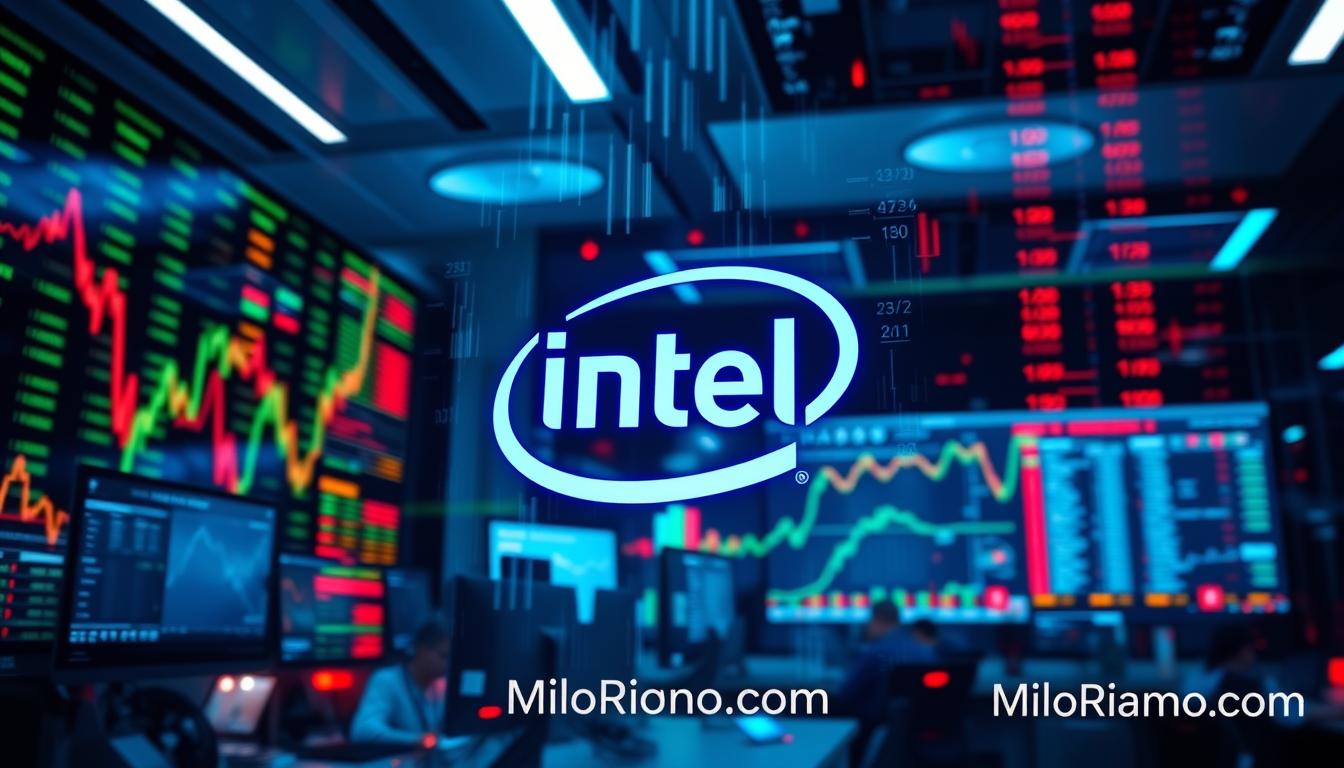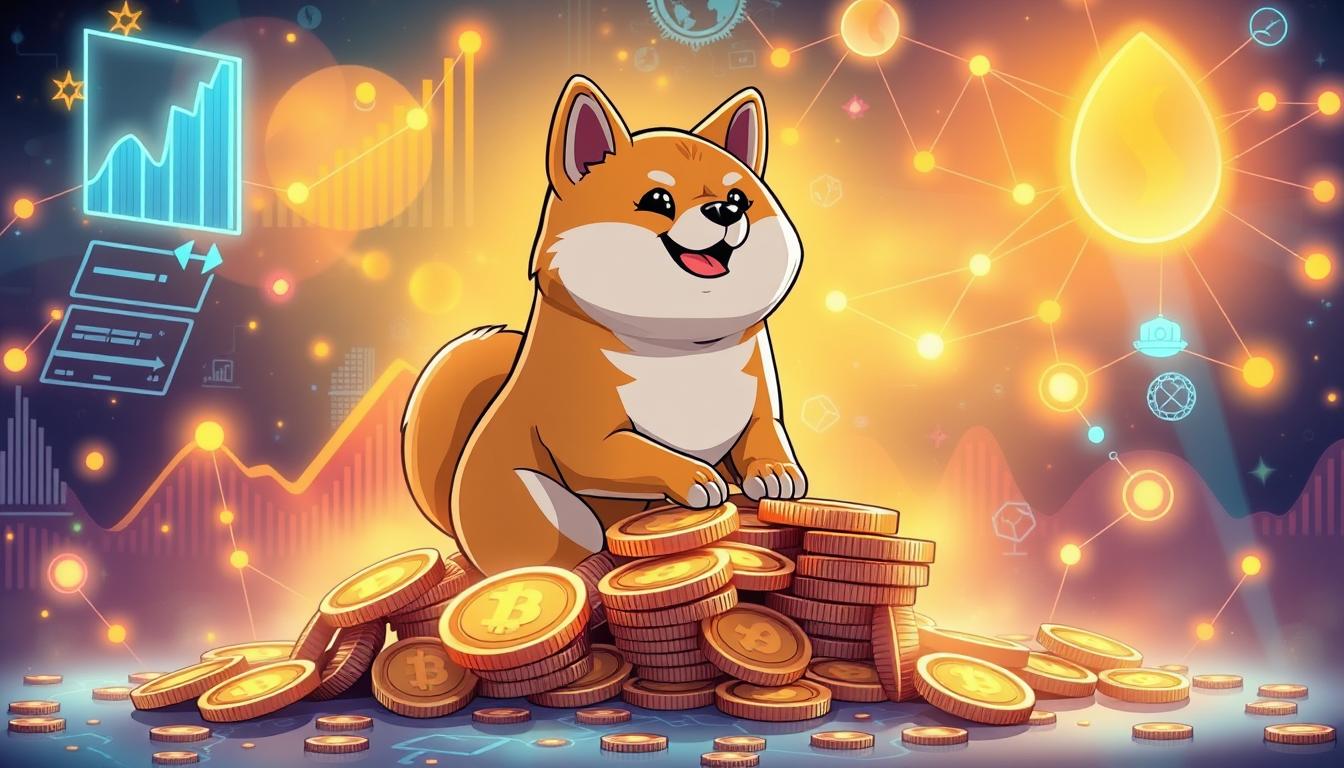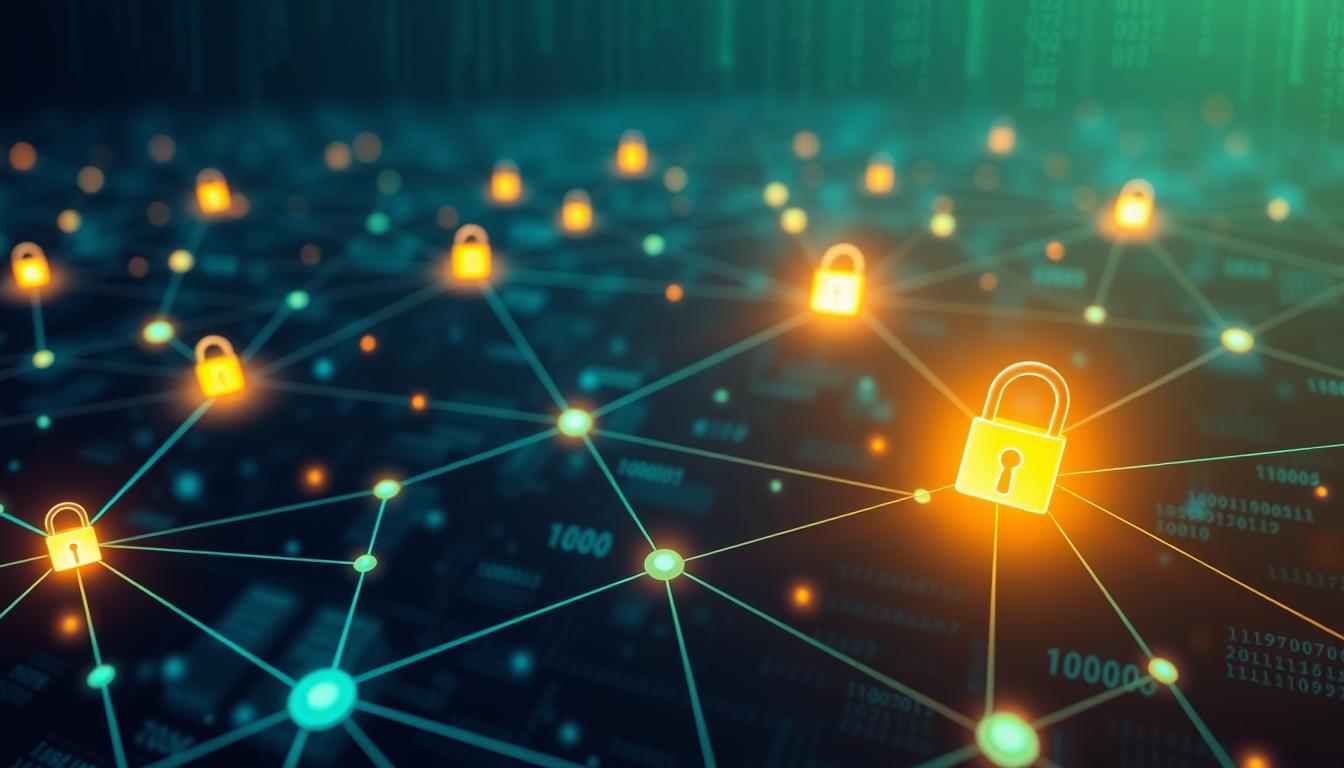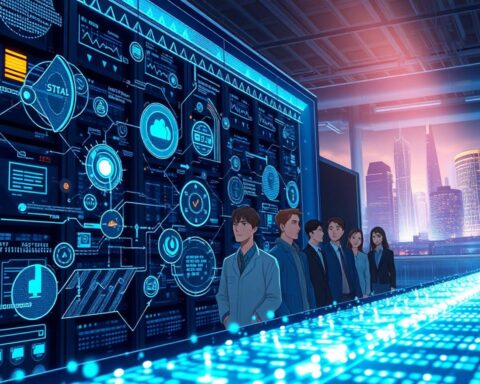Intel’s CEO Pat Gelsinger left suddenly, adding to the company’s tough times. Intel’s stock and market value have dropped a lot1. When Gelsinger left, Intel’s stock went up at first but then fell 0.5%1.
Intel has faced many problems under Gelsinger. Its focus on making chips for others has hurt its money and sales2. In 2023, Intel’s sales fell to $54 billion, down by almost a third from when Gelsinger started2. This big drop in money has made Intel’s value fall below $100 billion for the first time in 30 years.
Key Takeaways
- Intel CEO Pat Gelsinger’s ouster marks a turbulent period for the company, as it grapples with declining stock price and market cap.
- Gelsinger’s focus on the contract manufacturing business has hurt Intel’s cash flow and revenue, which shrank by nearly one-third during his tenure.
- Intel’s market cap has dropped below $100 billion for the first time in 30 years, reflecting the company’s financial challenges.
- The mixed market reaction to Gelsinger’s removal highlights the uncertainty surrounding Intel’s future direction and competitiveness in the tech industry.
- Investors and analysts will closely monitor Intel’s next steps as it navigates a leadership transition and addresses its strategic challenges.
Intel’s Recent Market Performance and Stock Decline
Intel, a tech giant, has seen tough times in recent years. Its stock price has dropped by 52% in 2024 alone3. This big drop has also cut Intel’s market value, making it less than $100 billion for the first time in over 30 years3.
The company’s money troubles are clear, with a 6% drop in revenue and a $16.6 billion loss in the latest quarter4. This bad news has made investors lose faith, with Intel’s shares down over 50% this year4. In contrast, companies like NVIDIA are doing well, thanks to AI, and even joined the Dow Jones industrial average3.
Intel’s struggles are clear to the market. Its stock has a fair RV rating of 0.80 and a below-average RS rating of 0.814. This means it’s seen as having limited growth and more risk. The overall VST rating for Intel is 0.98, leading to a HOLD recommendation for investors4.
| Metric | Value |
|---|---|
| Intel’s Market Cap | $103 billion5 |
| Intel’s Revenue (LTM) | $54.25 billion5 |
| Intel’s Return on Equity (LTM) | -16%5 |
| Server CPU Market Size | 6 million units per quarter (unchanged from 2017)5 |
| Desktop CPU Units | On the decline5 |
| Notebook CPU Units | Steady at around 52 million units per quarter for the past 15 years5 |
The data shows Intel’s stock and investment outlook are concerning. With tough competition, mistakes, and money issues, investors need to think carefully before investing345.
Pat Gelsinger’s Departure: Understanding the Decision
Intel’s board of directors has made a shocking move, announcing CEO Pat Gelsinger’s departure6. Gelsinger, who came back to Intel in 2021 with big plans, is stepping down right away6. This move shows the tough times Intel has seen, with problems in leadership and how the company is run.
Gelsinger’s plan to spend $100 billion on chips wasn’t enough to keep up with rivals in AI6. Intel’s results were not as good as those of companies like Taiwan’s TSMC. This led the board to decide that a new leader was needed to win back investor trust.
Frank Yeary, Intel’s interim executive chair, played a big role in Gelsinger’s exit6. Yeary’s influence and the board’s unhappiness with Gelsinger’s leadership made this change happen.
“The board concluded that a change in leadership is needed at this time,” Yeary said in a statement, highlighting the need for a new vision to tackle Intel’s challenges.
Intel is at a key moment in its history with Gelsinger leaving. His experience as Intel’s first chief technology officer makes his departure even more significant. It raises big questions about Intel’s ability to stay competitive in the fast-changing tech world.
The Biden administration’s promise to support US chip factories with billions of dollars gives Intel a chance to shine6. But, the path ahead is unclear. Intel’s success will depend on its ability to change and innovate with new leadership6.
Intel Stock A Buy after CEO is Ousted?
Pat Gelsinger’s departure has investors questioning if Intel’s stock is worth buying. The semiconductor industry is highly competitive and volatile in 20241. It’s important to look at Intel’s market value, investor feelings, and possible risks for buyers.
Current Market Valuation Analysis
Intel’s stock price has dropped by over 50% this year2. Yet, the stock is seen as undervalued, trading at just 1.96 times sales1. Intel’s Q3 earnings showed a 6% revenue drop, but it beat expectations. The company also reported a wider-than-expected loss per share1.
Investor Sentiment and Market Response
The market initially reacted positively to Gelsinger’s departure, with shares rising 6% before falling 0.5%1. Investors were hopeful after a tough year, but analysts are cautious about Intel’s future1. The consensus rating is “Hold,” with one “Strong Buy,” 30 “Hold,” one “Moderate Sell,” and four “Strong Sell” recommendations1. Analysts predict a 15.6% upside in Intel’s stock price1.
Risk Assessment for Future Buyers
Intel’s stock might seem undervalued, but there are big risks for buyers. The company faces tough competition from Nvidia and Advanced Micro Devices, Inc1.. Intel has seen revenue decline, job cuts, and huge investments in chip manufacturing, affecting its cash flow and debt2. The search for a new CEO adds to the uncertainty, as the market watches Intel’s new direction.
Intel’s stock might be an opportunity for some investors, but the challenges are real. It’s vital to analyze the market, financials, and leadership change to decide if Intel is a buy or sell now.
Intel’s Competitive Position in the AI Chip Market
Intel is facing tough competition in the AI chip market. Nvidia has taken the lead, with its stock up 186% this year. Intel, on the other hand, has seen its stock drop by 49% this year7.
Nvidia has excelled in areas like gaming, blockchain, and generative AI. Intel has not kept up with the demand for these technologies7.
Intel’s data center unit saw $25.8 billion in revenue in 2021. But, it’s expected to drop to around $12.81 billion in 20247. AMD’s data center business is projected to reach about $12.88 billion this year7.
| Company | Revenue (2021) | Data Center Revenue (2021) | Data Center Revenue (2024 Estimate) |
|---|---|---|---|
| Intel | – | $25.8 billion | $12.81 billion |
| AMD | $16.4 billion | Mid-20% of total revenue, or $4.1 billion | $12.88 billion |
Intel’s shares went up 4% after CEO Pat Gelsinger retired. But, they are down 49% this year. AMD’s shares rose 3% on the news, reaching $142 each7.
Intel needs to regain its edge in the AI chip market. Its success will shape its future in the tech world.
Financial Impact of Gelsinger’s Manufacturing Strategy
Intel’s former CEO, Pat Gelsinger, had a bold vision to boost the company’s role in the semiconductor world8. He planned to spend $100 billion on new chip factories in Arizona, Ohio, and other key places8. This move aimed to challenge giants like TSMC and Samsung, who lead the chip market.
To make this big plan work, Intel got big government deals and a $7.86 billion grant from the U.S. CHIPS and Science Act8. This support was key to increasing Intel’s chip making in the U.S. and its tech industry standing8.
But, Gelsinger’s plan had its downsides. The huge investments in new factories and buying Altera for about $17 billion in 20159 hurt Intel’s money flow and debt8. This financial burden has made Intel face tough times, including a loss and a bad sales forecast. It even stopped paying its dividend, which it had done for 29 years8.
| Key Financial Impact of Gelsinger’s Strategy | Details |
|---|---|
| $100 Billion Investment in Chip Fabs | Intel is spending heavily to establish new chip manufacturing facilities in strategic locations, aiming to compete with industry leaders like TSMC and Samsung8. |
| Government Contracts and CHIPS Act Grant | Intel secured government contracts for secure chips and received a $7.86 billion grant from the U.S. CHIPS and Science Act to support its domestic manufacturing efforts8. |
| Cash Flow and Debt Implications | The substantial investments in new fabs and acquisitions like Altera have strained Intel’s cash flow and increased its debt levels, contributing to the company’s financial struggles89. |
As Intel deals with these financial hurdles, its new leadership, with co-CEOs David Zinsner and Michelle Johnston Holthaus10, will be key. They will help shape Intel’s future and decide the lasting effects of Gelsinger’s strategy.
Intel’s bold plans have led to big financial challenges, with huge investments in new chip factories and government support89. Intel’s success in managing these financial issues will be vital for its future in the tech world8910.
New Leadership Structure: Co-CEO Arrangement
The board at Intel has chosen David Zinsner, the CFO, and Michelle Johnston Holthaus, the head of client computing, as interim co-CEOs11. They aim to bring both financial and product expertise to the top during a tough time. This comes after the departure of CEO Pat Gelsinger12.
Zinsner brings over 25 years of experience from Micron Technology to Intel, starting in January 202212. Holthaus, with Intel for 28 years, has led the client computing group12.
The board chose Zinsner and Holthaus to manage Intel’s finances and products while finding a new CEO11. Gelsinger, who spent over 40 years at Intel, left on December 1, 202412.
This co-CEO setup aims to stabilize Intel during a tough time. Zinsner’s finance skills and Holthaus’s product knowledge are key to Intel’s future12.
As Intel looks for a permanent CEO, the co-CEO plan is a key step. It’s aimed at setting new strategic goals and regaining Intel’s leading role in tech11. The success of this plan will be watched closely by many12.
Intel’s Strategic Challenges in the Tech Industry
Intel was once a top player in tech, but now faces big challenges. It’s hard for the company to keep up with the fast-changing AI chip market. Intel can’t match the making skills of rivals like TSMC and Samsung, putting it in a tough spot13.
Competition with TSMC and Samsung
Intel’s focus on PCs has hurt it as the industry moved to new areas like gaming and AI. Nvidia’s GPUs have done well in these fields13. Intel’s foundry business has lost over $11 billion in the first nine months of 2024. This shows it’s hard for Intel to compete with TSMC and Samsung’s advanced chip making14.
Missing the AI Revolution
Intel missed the AI revolution, which has hurt it a lot. Nvidia’s data center GPUs are expected to make nearly $83 billion this year. Intel’s Gaudi GPU chip won’t hit its $500 million goal this year14. Intel’s problems in the AI chip market have made it less dominant in tech13.
To get back on track, Intel needs to tackle these challenges and change its business model. The new leadership at Intel has a big job ahead. They aim to make Intel great again and lead the industry14.
Organizational Issues and Internal Structure Problems
Intel’s problems go beyond just leadership changes. Experts say the company’s structure and pay system play big roles15. The internal setup is stuck in a silo mentality, with different teams working alone15. This makes things inefficient and creates big problems for Intel.
Intel’s pay system also gets in the way. It rewards short-term gains over long-term plans15. The former CEO, Pat Gelsinger, got a huge $178.5 million package in 2021, mostly in shares15. This big pay and Gelsinger’s short time as CEO raise questions about Intel’s ability to make lasting decisions.
Intel’s pay system is a big problem. It focuses on quick wins over long-term goals15. The former CEO, Pat Gelsinger, got a huge $178.5 million package in 2021, mostly in shares15. This big pay and Gelsinger’s short time as CEO raise questions about Intel’s ability to make lasting decisions.
As Intel changes, fixing these deep problems is key15. The new leaders, including CFO David Zinsner and division head Michelle Johnston Holthaus, must create a united and forward-thinking culture15. Only by solving these internal issues can Intel start to compete again in the fast-changing tech world.
| Metric | Value |
|---|---|
| CEO Compensation | $178.5 million |
| CEO Severance | $10 million |
| Qualcomm Market Cap | $180 billion |
| Intel Losses | $17 billion |
| Intel Workforce Reduction | 15% |
| Intel Market Value | $106 billion |
“Intel’s internal structure reportedly pits internal fiefdoms against each other, creating disconnects between engineering, marketing, and customer-focused departments. This organizational issue is seen as a fundamental problem that needs addressing before Intel can effectively compete in the market.”
Intel’s problems go beyond just leadership changes. Its structure and pay system are major issues15. Fixing these deep problems is essential for Intel to compete in the fast-changing tech world15.
Future Growth Prospects and Market Opportunities
Intel is working hard to regain its lead in manufacturing and grow in the future1. Frank Yeary, the interim executive chair, says they aim to be top in manufacturing again16. This move is to make Intel more efficient and profitable, keeping it a leader in the tech world.
To meet these goals, Intel wants to be leaner and more agile16. They’re looking to sell some parts, like Altera, to make more money and gain investor trust.
Manufacturing Leadership Goals
Intel’s main goal is to be the top in manufacturing again9. They’ve stopped building new plants in Poland and Germany to figure out the best way to make things9. They’re also thinking about teaming up with investors for Altera to boost research and development.
Product Portfolio Restructuring
Intel is also changing its product lineup16. They want a more agile and focused range that meets the tech industry’s needs1. They’re focusing more on Data Center and AI, which saw a 9% revenue increase in Q3.
By improving manufacturing and product lines, Intel is ready to grab new opportunities and stay ahead in the tech world1169.
“We are focused on returning to process leadership as central to our product leadership objectives.”
– Frank Yeary, Interim Executive Chair, Intel
Investment Risks and Market Analysis
Intel is facing tough times, and experts doubt a quick turnaround17. The company’s success in the past has made it complacent17. This has led to problems adapting to new market realities17.
Intel’s internal rivalries and structure are major obstacles17. Without fixing these issues, Intel’s stock recovery seems unlikely soon.
Intel’s market cap has dropped below $103 billion17. The stock has fallen by 46.7% in the last 52 weeks17. It has lost more than half its value in just January17.
Intel’s stock hit a record high of $75.81 in 200017. Now, it’s a far cry from that peak.
Despite a low valuation of 1.96 times sales17, investors are cautious4. Intel’s recent financials have been disappointing, with a 6% revenue drop to $13.3 billion in Q317.
The company lost $0.46 per share, including one-time costs17. The Data Center and AI segment saw a 9% revenue increase17. But, the Client Computing Group’s PC chip sales fell by 7%17.
Wall Street analysts give Intel a “Hold” rating17. The average price target is $26.5517. The rating breakdown shows a mix of opinions, with 1 “Strong Buy,” 30 “Hold,” 1 “Moderate Sell,” and 4 “Strong Sell” recommendations17.
In summary, Intel’s stock situation is complex. The company’s valuation might look good, but challenges and market sentiment are not optimistic. Investors should watch Intel’s efforts to fix its problems and adapt to the changing semiconductor industry.
Path Forward: Strategic Priorities and Transformation
Intel is at a critical point in its history. The board is working hard to change the company’s direction. They aim to improve its position in the tech world18.
The company is simplifying its products and improving its manufacturing. They also want to cut costs and make its finances stronger18.
Operational Efficiency Measures
Intel has new leaders, David Zinsner and Michelle Johnston Holthaus. They are working fast to make the company more efficient and save money19.
The goal is to use Intel’s big resources and global presence to boost profits. They also want to fix the company’s internal problems18.
Product Development Focus
Intel knows the tech world is changing fast. They’re focusing on making better products, like AI accelerators and GPUs18.
The company is investing in its core areas, like making chips and manufacturing. They want to lead the market again and meet their customers’ needs18.
This change will make Intel more flexible and quick to respond to new trends18.
FAQ
What led to Intel CEO Pat Gelsinger’s removal?
How has Intel’s stock price performed recently?
What was Gelsinger’s strategy, and why did it fail?
How has Intel’s leadership transition unfolded?
What are the key challenges Intel faces in the tech industry?
What are Intel’s strategic priorities under the new leadership?
Is Intel stock a buy after the CEO’s ouster?
Source Links
- RCM Co-op – – https://www.rpafarmers.com/news/story/29871864/down-53-ytd-is-intel-stock-worth-the-risk
- Why Intel Stock May Fall After Its CEO’s Removal – https://www.forbes.com/sites/petercohan/2024/12/02/intel-stock-may-fall-if-he-couldnt-fix-it-can-anyone-asks-expert/
- Intel’s CEO had big plans for a turnaround. It failed, and now he’s gone – https://fortune.com/2024/12/02/intel-stock-pat-gelsinger-retires/
- Intel Faces CEO Departure Amid Struggles in the AI Chip War – https://www.vectorvest.com/blog/hot-stocks/intel-faces-ceo-departure-amid-struggles-in-the-ai-chip-war/
- Evercore ISI maintains In Line rating on Intel stock amid CEO transition By Investing.com – https://www.investing.com/news/analyst-ratings/evercore-isi-maintains-in-line-rating-on-intel-stock-amid-ceo-transition-93CH-3750696
- Intel CEO Pat Gelsinger leaves after given two choices by the Board: Retire or be … – Times of India – https://timesofindia.indiatimes.com/technology/tech-news/intel-ceo-pat-gelsinger-leaves-after-given-two-choices-by-the-board-retire-or-be-/articleshow/115910550.cms
- Jim Cramer says AMD stock is a buy on Intel’s CEO shakeup — ‘It’s winning’ – https://www.cnbc.com/2024/12/02/jim-cramer-says-amd-stock-is-a-buy-on-intels-ceo-shakeup.html
- Intel CEO forced out after board grew frustrated with progress – https://fortune.com/2024/12/02/intel-ceo-pat-gelsinger-resignation-intc-stock-turnaround-ai-chips-nvidia/
- Intel’s CEO Departure Opens Door to Fresh Deal Discussions – https://finance.yahoo.com/news/intel-ceo-departure-opens-door-021652383.html
- Intel CEO Pat Gelsinger pushed out following tumultuous tenure leading the chip giant – https://finance.yahoo.com/news/intel-ceo-pat-gelsinger-pushed-out-following-tumultuous-tenure-leading-the-chip-giant-145239928.html
- Intel’s CFO has a tough new job: Serve as co-CEO to keep its finances from further ‘deteriorating’ – https://fortune.com/2024/12/03/intels-cfo-has-a-tough-new-job-serve-as-interim-co-ceo-to-keep-its-finances-from-further-deteriorating/
- Intel Announces Retirement of CEO Pat Gelsinger – https://www.gurufocus.com/news/2619854/intel-announces-retirement-of-ceo-pat-gelsinger
- Intel’s Strategic and Operational Challenges Lead to Hold Rating Amid CEO Departure and Market Setbacks – https://markets.businessinsider.com/news/stocks/intel-s-strategic-and-operational-challenges-lead-to-hold-rating-amid-ceo-departure-and-market-setbacks-1034090154
- Are Intel’s problems too big to fix? – https://finance.yahoo.com/news/intel-problems-too-big-fix-103000356.html
- Can Intel recover? Gelsinger’s exit sparks speculation and uncertainty | CTech – https://www.calcalistech.com/ctechnews/article/pjlvfxhzf
- Intel CEO Transition: Challenges and Opportunities Ahead – https://www.gurufocus.com/news/2620416/intel-ceo-transition-challenges-and-opportunities-ahead
- Down 53% YTD, Is Intel Stock Worth the Risk? – https://www.tradingview.com/news/barchart:ff2d1cef3094b:0-down-53-ytd-is-intel-stock-worth-the-risk/
- Intel CEO Forced Out After Board Grew Frustrated With Progress – Bloomberg Businessweek | iHeart – https://www.iheart.com/podcast/1308-bloomberg-businessweek-30972793/episode/intel-ceo-forced-out-after-board-244339193/
- Intel CEO Pat Gelsinger Forced Out By Board Amid Semiconductor Market Challenges – 9meters – https://9meters.com/technology/pc/intel-ceo-pat-gelsinger-ousted-by-board







